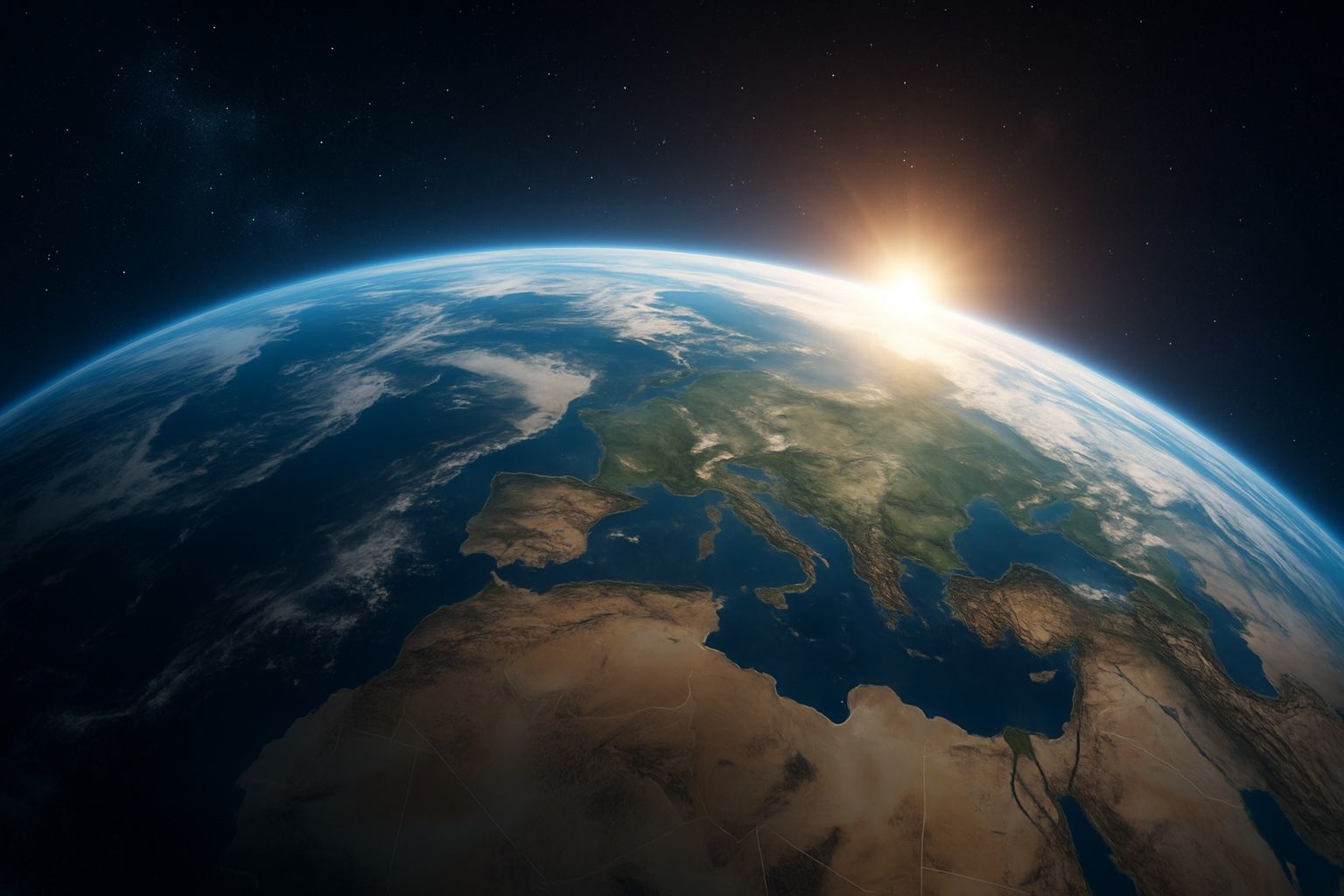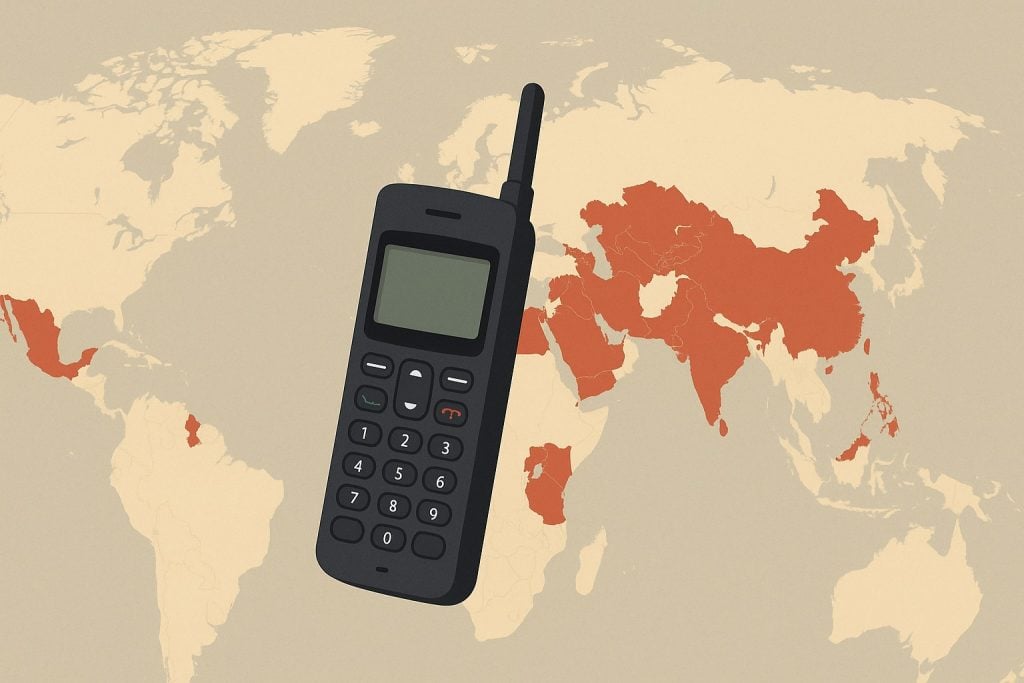- Radar altimeters on TOPEX/Poseidon, Jason-1, Jason-2, Jason-3, and Sentinel-6 Michael Freilich have provided a global mean sea level record since 1992, showing a rise of about 3.3 millimeters per year and roughly 10 centimeters over 30 years.
- Arctic summer sea ice extent has declined by about 12% per decade since the 1980s, with the Arctic minimum shrinking from about 7.5 million km² in 1980 to 4.4 million km² in 2023.
- GRACE and GRACE-FO gravity missions have revealed that Greenland and Antarctica are losing hundreds of billions of tons of ice each year, contributing to sea level rise.
- NASA’s PACE mission, launched in early 2024, carries next‑generation ocean-color instruments to monitor plankton and ocean health, including carbon uptake.
- TEMPO, launched in 2023 on a commercial satellite in geostationary orbit, provides hourly maps of ozone, NO2, and formaldehyde over North America at city‑scale resolution.
- Sentinel-6 Michael Freilich, launched in 2020, continues precision sea level monitoring, with Sentinel-6B planned for 2025 to extend the record.
- NASA’s OCO-2, launched in 2014, uses high‑resolution spectrometers to map atmospheric CO₂ concentrations globally, with OCO-3 following as a subsequent mission.
- There are more than 150 Earth observation satellites currently in orbit, delivering a global view of climate indicators.
- Landsat and Sentinel-2 imagery have documented rapid deforestation in the Brazilian state of Rondônia, showing a fishbone pattern of cleared land spreading from roads.
- The IPCC Sixth Assessment report cites ESA’s Climate Change Initiative, noting that ESA CCI datasets and papers underpin the evidence for climate change.
Satellites have become our planet’s orbiting guardians, silently circling Earth and gathering data that help scientists unravel the story of climate change. Using advanced sensors, these high-tech observers measure everything from global temperatures and greenhouse gas levels to shrinking ice sheets and disappearing forests. The result is a revolution in climate monitoring – a wealth of information about Earth’s systems that was unimaginable just a few decades ago. This report explores what satellite remote sensing is, how it works, and the key ways satellites are transforming our understanding of climate change. We’ll look at the technologies involved, the breakthroughs enabling ever sharper insights, the benefits for science and society, and also the challenges and limitations of watching the world from space. By the end, you’ll see why agencies like NASA, NOAA, and ESA – and the IPCC itself – view satellites as essential tools in the fight against climate change [1].
What Is Satellite Remote Sensing?
Satellite remote sensing is the science of obtaining information about objects or areas from a distance – in this case, using satellites high above Earth [2]. Instead of physical thermometers or rain gauges on the ground, satellites use sophisticated instruments to detect energy (such as light or heat) that is reflected or emitted from Earth’s surface and atmosphere. By measuring these signals, satellites can infer a huge range of environmental properties. For example, a weather satellite might measure the infrared radiation coming off clouds to determine their temperature, or a land satellite might record reflected sunlight to map forests and crops.
How it works: Some satellite sensors are passive – they simply record natural energy like sunlight reflected off Earth or thermal radiation emitted by the planet [3]. Others are active – they emit their own signals (such as radar pulses or laser beams) towards Earth and measure the return signal, like a bat using sonar [4]. A familiar example of active sensing is radar altimetry, where a satellite bounces a microwave pulse off the ocean surface to precisely measure sea level. Passive sensors include the cameras and radiometers that take multi-spectral images of Earth in visible and infrared light, revealing everything from vegetation health to sea-surface temperature.
Satellites carrying these instruments typically orbit in one of two regimes. Polar-orbiting satellites sweep from pole to pole at a few hundred kilometers up, catching the entire globe strip by strip as Earth rotates beneath them [5]. Many of these orbits are sun-synchronous, meaning the satellite passes over each area at the same local time daily – useful for consistent lighting in images [6]. In contrast, geostationary satellites park at about 36,000 km above the equator, moving at the same rotation rate as Earth so they hover over one spot [7] [8]. These provide continuous coverage of the same region (often used for real-time weather monitoring), though their view is limited to their hemisphere. Thanks to a fleet of satellites in different orbits, we can get both detailed global snapshots and constant watch over key areas.
One remarkable fact is just how much of our climate knowledge now depends on satellites. Over half of the essential climate variables identified by scientists – things like atmospheric composition, ocean heat, or ice cover – can only be measured from space [9]. More than 150 Earth observation satellites are currently in orbit, providing an indispensable global view of climate indicators [10]. These remote eyes give us data across the entire planet, including regions that are hard to measure on the ground (such as open oceans, deserts, and the polar ice caps). As the IPCC’s Sixth Assessment emphasizes, space-based observations are a critical tool to monitor the causes and effects of climate change [11]. In short, satellite remote sensing is how we “take the pulse” of Earth from afar, turning streams of sensor readings into actionable information about our world.
How Do Satellites Monitor Earth’s Climate?
Satellites monitor Earth’s climate by tracking a suite of key indicators over time. Different sensors specialize in measuring different aspects of the climate system. By combining these observations, scientists assemble a comprehensive picture of changes in the atmosphere, oceans, ice, and land. Below are some of the major climate monitoring applications of satellite remote sensing, and how they work:
Tracking Global Temperature and Weather Patterns
One of the most fundamental climate metrics is temperature – not just at the surface, but through the atmosphere and across the world. Satellites have revolutionized temperature monitoring by providing truly global coverage, including over remote oceans and polar regions where ground stations are sparse [12].
- Surface temperatures: Satellites like NOAA’s weather satellites and NASA’s Terra/Aqua (with MODIS sensors) scan the Earth in infrared wavelengths to map land and sea surface temperatures. These thermal images show which areas are hot or cold and how those patterns shift over days, seasons, and years. By compiling long-term records, scientists confirmed that Earth’s surface has been warming, with the most rapid increases in recent decades occurring in the Arctic and over land areas [13]. For instance, satellite data contributed to observing that the planet’s average surface temperature has risen about 1°C (almost 2°F) since pre-industrial times, a trend the IPCC has declared “unequivocal” evidence of climate change.
- Atmospheric temperatures: Special satellite instruments called microwave sounders peer into the layers of the atmosphere. They measure natural microwave emissions that vary with air temperature at different altitudes. Using this method, scientists have created temperature records for the troposphere (the lowest 8–16 km of atmosphere) and the stratosphere above it. Notably, satellites detected that while the lower atmosphere is warming, the stratosphere is actually cooling – a pattern consistent with greenhouse gas effects (warming below, cooling above, due to trapping heat in the troposphere). These observations, started in 1979, complement surface thermometer records and help validate climate model predictions of atmospheric warming rates.
- Weather and extreme events: Geostationary satellites like NOAA’s GOES series continuously watch cloud development, storms, and humidity, aiding short-term weather forecasting. In a climate context, this provides insight into changing weather extremes. For example, satellites track heatwaves via land surface temperature anomalies and monitor hurricane frequency and intensity via cloud imagery and thermal structure. This helps climatologists see if tropical cyclones are growing stronger over warmer oceans, or if severe heat events are becoming more common – information directly related to climate change impacts.
Satellites essentially act as thermometers in the sky, measuring the Earth’s fever in multiple ways. Their temperature readings strongly contributed to the conclusion that each of the past several decades has been warmer than the last, and helped identify phenomena like Arctic amplification (the Arctic warming much faster than the global average) [14]. By capturing data across the entire planet, satellites ensure that no region’s changes go unnoticed, filling gaps left by ground-based monitoring [15]. This global perspective is vital for assessing climate change, which, after all, is a planet-wide problem.
Measuring Sea Level Rise and Ocean Changes
If global warming has a “fingerprint,” one of the clearest is rising sea level. As oceans heat up and land ice melts, the volume of water in the oceans increases. But how do we measure the height of something as vast and constantly moving as the sea? The answer is satellite radar altimetry.
- Sea level monitoring: Since 1992, a series of specialized satellites (TOPEX/Poseidon, Jason-1/2/3, and the recent Sentinel-6 Michael Freilich) have been equipped with radar altimeters that bounce radio waves off the ocean surface. By timing the round-trip of the signal (travelling at the speed of light), they determine the distance to the sea surface with centimeter accuracy. These missions have produced a high-precision record of global mean sea level spanning three decades. The result? We have observed that sea levels are rising at an accelerating rate, currently about 3.3 millimeters per year on average [16]. That may sound small, but it adds up: over 30 years, that’s roughly 10 cm (4 inches), and the rate is increasing. In fact, scientists report the pace of rise has more than doubled compared to the early 20th century [17]. Satellite altimetry not only measures the increase, but also maps regional variations – for instance, some areas of the Western Pacific are rising faster than the global average, affecting certain coastlines more.
- Ocean temperatures and heat storage: Because water expands as it warms, satellites measuring sea level can indirectly infer that oceans are absorbing tremendous heat (about 90% of the excess heat trapped by greenhouse gases ends up in the oceans) [18]. Additionally, other satellite sensors monitor sea-surface temperature directly, as mentioned above, and instruments like NASA’s new SWOT (Surface Water and Ocean Topography) mission (launched 2022) will measure not just open ocean levels but also coastal sea levels and even large rivers. Together, these observations help track the oceans’ role in climate – from driving El Niño events to fueling hurricanes with warmer waters.
- Ocean health indicators: Beyond physical measurements, satellites also gauge oceanic conditions like color and chemistry that are relevant to climate. For instance, NASA’s recently launched PACE satellite (2024) carries an advanced sensor to monitor ocean color, which reveals phytoplankton concentrations and ocean ecosystem health [19]. Since phytoplankton absorb CO₂ and form the base of the marine food web, satellites tracking their blooms help scientists understand the carbon cycle and how marine life is responding to climate change. Ocean color data can also indicate coral reef bleaching events (whitening of reefs when ocean water gets too hot) by detecting changes in reef areas’ color from space.
Satellites thus provide an early warning system for the state of the oceans. By continuously surveying sea level and surface conditions, they make clear that our seas are rising and warming – information crucial for coastal communities planning defences. As one NASA scientist put it, “Satellites are the most important tool to tell us the rate of sea-level rise… a bellwether of global warming that will inundate coastlines” [20]. Thanks to these orbiting instruments, we’re able to quantify this bellwether with unprecedented accuracy and use it to anticipate future changes [21].
Monitoring Greenhouse Gases and Air Quality
Satellites have become indispensable for tracking the composition of Earth’s atmosphere, including the buildup of greenhouse gases (GHGs) that drive global warming. Traditional GHG monitoring relied on a network of surface stations (like NOAA’s observatory at Mauna Loa, Hawaii, famous for CO₂ records). Now, satellites complement and expand that picture by mapping gases across the globe:
- Carbon dioxide (CO₂): In the past decade, dedicated satellites such as NASA’s OCO-2 (Orbiting Carbon Observatory-2) and its predecessor OCO-3, as well as China’s TanSat and others, use high-resolution spectrometers to measure CO₂. They observe the spectrum of sunlight reflected off Earth; CO₂ absorbs specific wavelengths, so the “fingerprint” of absorption reveals the concentration of CO₂ below the satellite. These missions have generated global CO₂ maps, showing, for example, how concentrations peak in the Northern Hemisphere spring and where major sources and sinks are. While still a newer data source (OCO-2 launched in 2014), satellites promise to monitor compliance with emission reductions by identifying large CO₂ plumes from cities or power plants. Plans are underway in Europe for the Copernicus CO2M mission to launch a constellation of CO₂-tracking satellites later in the 2020s, which would greatly enhance our ability to spot regional emissions changes from space.
- Methane (CH₄) and other gases: Methane is a potent greenhouse gas, and satellites are stepping up our ability to monitor it. ESA’s Sentinel-5P satellite (with the TROPOMI instrument) and various smaller missions have detected methane “hotspots” – for example, leaks from gas pipelines or major wetlands emissions. In one case, scientists used satellite data to discover large methane releases from oil and gas operations that were previously unreported, giving governments a chance to target and reduce those emissions [22]. Other gases like nitrous oxide or carbon monoxide are also observed by satellites, which helps in understanding pollution sources and chemical reactions in the atmosphere.
- Air quality and aerosols: While not a greenhouse gas, air pollutants and aerosols (tiny particles in the air) are closely tied to climate and often measured by the same satellite instruments. NASA’s new TEMPO instrument (launched 2023 on a commercial satellite) provides hourly, neighborhood-scale monitoring of pollutants like ozone, NO₂, and formaldehyde over North America [23]. This is a breakthrough in resolution – previously, satellites gave at best daily snapshots. With TEMPO’s high detail, scientists and local authorities can see how pollution builds up in cities each day or how wildfire smoke spreads, in near-real time [24]. Aerosols (like dust, smog, and volcanic ash) are tracked by sensors such as MODIS and VIIRS using the way particles scatter sunlight. These measurements feed into climate models, since aerosols affect climate by altering clouds and blocking sunlight. Importantly, satellites have confirmed a general decline in some pollutant levels in parts of the world (thanks to clean-air policies) even as greenhouse gases continue rising.
All these atmospheric observations are critical for understanding the drivers of climate change. They allow scientists to verify that the increase in GHG concentrations is indeed global and human-caused, and to track shorter-lived climate forcers like soot or ozone. The IPCC reports heavily utilize satellite data on GHGs, citing space-based measurements of rising CO₂ and CH₄ as evidence of anthropogenic influence. Furthermore, this capability means we can monitor international climate commitments (e.g. detecting if a country’s emissions are decreasing as promised) from an objective vantage point – space. In sum, satellites serve as a planetary-scale air monitoring network, sniffing out the gases and particles that are warming the climate or affecting air quality, anywhere on Earth.
Observing Ice Melt and the Cryosphere
Few images of climate change are as visually striking as the reduction of ice in Earth’s cold regions – the cryosphere. From the shrinking Arctic sea ice cap to melting mountain glaciers and the great ice sheets of Greenland and Antarctica, satellites have been instrumental in measuring these changes with precision:
- Arctic and Antarctic sea ice: Satellites have monitored sea ice extent continuously since 1979 using passive microwave sensors (on missions like NASA’s Nimbus-7 and the DMSP series). These sensors detect the unique microwave emissions from ice versus open water, allowing calculation of ice-covered area even through clouds or polar night. The long-term record reveals a dramatic decline in Arctic sea ice. Summer (September) Arctic sea ice extent has been shrinking at roughly 12% per decade in area since the 1980s [25]. In absolute terms, the Arctic minimum went from about 7.5 million km² in 1980 to just 4.4 million km² in 2023 – losing an area of ice nearly the size of the continental United States over that period [26]. Satellites also show the ice that remains is younger and thinner than before [27]. This decline in sea ice is one of the clearest indicators of a warming climate, as highlighted in every IPCC report. In Antarctica, sea ice trends have been more complex, with some slight increases in the 20th century followed by recent record low extents; satellites are crucial in monitoring those remote seas and detecting shifts in ice coverage year to year.
- Glaciers and ice sheets:Glaciers worldwide – from the Himalayas to the Alps to Alaska – are tracked by satellites using optical imagery to map glacier outlines and laser altimetry to measure elevation change. NASA’s ICESat-2 (launched 2018) fires laser pulses and measures the return timing to gauge ice surface height within a few centimeters; repeating passes can detect thinning of glaciers or ice sheets over time [28]. Additionally, a pair of satellites known as GRACE (and the successor GRACE-FO) detect changes in Earth’s gravity field caused by shifting mass – an ingenious way to “weigh” ice sheets. GRACE data revealed that Greenland and Antarctica are losing hundreds of billions of tons of ice per year, contributing significantly to sea level rise. For example, Greenland’s melt has accelerated in the 21st century, and satellites have been able to pinpoint where ice loss is happening (coastal outlet glaciers thinning and retreating). These observations were impossible at a global scale before satellites – we now have a continuous, quantitative record of ice mass loss.
- Snow cover and permafrost: Satellites also map seasonal snow cover on land via optical sensors (snow has a distinct reflectance, bright in visible light). They document trends like earlier spring snowmelt in many regions. Some satellites, like Europe’s SMOS, even estimate soil freeze-thaw cycles and permafrost changes indirectly through microwave readings of ground moisture. This is important because thawing permafrost can release methane and CO₂, amplifying warming. The extent of high-altitude and high-latitude snow and ice is another essential climate variable tracked from space, reflecting changes in water resources and surface reflectivity (albedo) that affect how much solar energy Earth absorbs.
Satellites have truly opened our eyes to the cryosphere. According to ESA’s climate program, “Remote sensing has revolutionised our knowledge of the world’s frozen areas, particularly near the poles where conditions make surface observations difficult.” [29]. Now we can measure, almost in real-time, the calving of a huge iceberg or the dwindling of mountain glaciers. This knowledge has concrete implications: communities rely on snowpack measurements for water supply forecasts, and global sea level rise projections hinge on knowing how fast ice sheets are melting. With satellite data, scientists provide early warnings – for instance, identifying instability in an Antarctic ice shelf that might collapse – giving the world a chance to prepare. In short, satellites are our polar sentinels, keeping watch over Earth’s icy realms as they respond to a warming climate.
Watching Forests, Land Use, and Ecosystems from Space
Climate change is not just about physics and chemistry – it’s also visibly changing Earth’s landscapes and ecosystems. Satellites are crucial for monitoring land cover on a global scale, including forests, agriculture, deserts, and urban areas. This helps track phenomena like deforestation, vegetation health, and even wildlife habitat changes that both impact climate and are impacted by it.
- Deforestation and land cover change: High-resolution imaging satellites (such as the US Landsat series, in operation since the 1970s, and the European Sentinel-2 satellites more recently) regularly photograph Earth’s land in visible and infrared bands. These images allow us to map forests in detail and detect changes when trees are cleared or burned. For example, satellites have documented the rapid deforestation in the Amazon and other tropical regions. One striking case is the Brazilian state of Rondônia, which lost so much forest that satellite images show a “fishbone” pattern of cleared land spreading out from roads [30]. Such data revealed that global tropical deforestation rates surged in certain years, contributing significantly to carbon emissions (forests store carbon, so when they’re cut or burned, CO₂ is released). Governments and organizations now rely on satellite monitoring for enforcing anti-deforestation policies – if a new clearing appears in a protected area, it can be spotted from space within days. In temperate and boreal zones, satellites track changes like wildfires (e.g., the huge Siberian fires in recent summers) or pest-driven forest die-offs, all relevant to climate because they alter carbon stocks and surface reflectivity.
- Vegetation health and drought: Beyond just forest extent, satellites also measure how “green” and productive vegetation is, often using indices like NDVI (Normalized Difference Vegetation Index) derived from red and infrared reflectance. This helps monitor drought stress on crops and grasslands. During major droughts or heatwaves, satellites have shown vegetation browning and reduced productivity, which can signal potential crop failures or increased wildfire risk. Programs like NASA’s MODIS Global Vegetation Index have created an invaluable record of the ebbs and flows of plant growth globally, showing trends like earlier spring greening in high latitudes (as growing seasons lengthen with warming) or trends of vegetation “browning” in some arid regions as climate shifts. These indicators tie into climate adaptation – e.g. helping predict food shortages or fire seasons.
- Desertification and land degradation: In semi-arid regions, satellites watch for expansion of deserts or loss of fertile land. Changes in land use, often exacerbated by climate change (like prolonged droughts), can be seen via reduced vegetation cover and changes in soil reflectance. Satellite time-series over decades in places like the Sahel in Africa have been used to monitor the success of regreening efforts and the impacts of rainfall variability on landscapes.
- Wildlife and ecosystems: While satellites can’t track animals directly, they provide context for ecosystems by mapping habitat extent and changes (like wetlands shrinking or coastal mangroves retreating). For marine ecosystems, as noted with PACE, satellites observe phytoplankton blooms via ocean color, which is key to understanding fisheries and ocean carbon uptake. Coral reef health can be indirectly monitored by looking at reef-covered pixels in high-res images or thermal stress from sea temperature maps (e.g., predicting coral bleaching events). In the Arctic, satellites even track tundra vegetation expansion and melting ponds as permafrost thaws. All these changes are pieces of the climate puzzle.
Taken together, these land and ecosystem observations illustrate how intimately climate change is linked with ecological change. They also underscore the role of human land use. For instance, satellites estimate that land use change (primarily deforestation) contributes roughly 10-15% of global CO₂ emissions – so tracking it is vital. The ability of satellites to provide objective, up-to-date maps of virtually every corner of Earth has empowered policymakers and conservationists. We can measure how much forest we’re losing each year or identify where to prioritize replanting. In one recent success, satellite alerts helped Brazil enforce protections and slightly reduce Amazon deforestation in certain periods by catching illegal logging quickly. Additionally, by monitoring fires, satellites support firefighting efforts and help quantify how much carbon those fires spew into the air.
Below is a summary table of key climate variables and how satellites observe them, with examples of prominent satellite missions:
| Climate Variable | How Satellites Measure It | Example Satellite Missions (Sensors) |
|---|---|---|
| Global Temperature | Infrared radiometers measure thermal emission from land and ocean surfaces; microwave sounders measure atmospheric temperatures in different layers. | NOAA Polar Orbiters (AVHRR sensor); NASA Terra/Aqua (MODIS); Aqua (AIRS atmospheric sounder) |
| Sea Level Rise | Radar altimeters send pulses to ocean surface and time the return to calculate sea surface height globally. | NASA/ESA Sentinel-6 & Jason series altimeters (continuity since 1992) |
| Greenhouse Gases | Spectrometers observe absorption lines in reflected sunlight to derive gas concentrations (e.g. CO₂, CH₄). | NASA OCO-2 (CO₂); ESA Sentinel-5P TROPOMI (CO₂, CH₄, etc.); Japan’s GOSAT |
| Ice and Snow | Passive microwave sensors map sea ice extent; laser altimeters and radar map ice height; gravimetric satellites track ice mass loss. | DMSP SSM/I (sea ice concentration); NASA ICESat-2 (ice elevation); NASA GRACE-FO (ice mass changes) |
| Forests & Land Cover | Optical imagers capture high-resolution repeated images to detect forest cover and changes (e.g., deforestation, fires, urbanization). | USGS/NASA Landsat series; ESA Sentinel-2; NASA MODIS (for global land cover and active fires) |
Table: Examples of climate monitoring by satellites. These missions help quantify changes in Earth’s vital signs, from warming temperatures to retreating ice and forests.
Benefits of Satellite-Based Climate Monitoring
Satellites have become the backbone of climate observation, offering numerous benefits that ground-based methods alone cannot match. Here are some of the major contributions and advantages of satellite remote sensing for understanding and responding to climate change:
- Global Coverage, Even in Remote Regions: Perhaps the biggest advantage is seeing the whole Earth. Satellites continuously cover areas that are otherwise data-sparse – open oceans, dense rainforests, deserts, polar ice fields. For example, vast stretches of the Arctic Ocean have no weather stations, but satellites still measure the temperature, ice cover, and cloud conditions there daily. This ensures that our picture of the climate is truly global, and that no significant change – be it ice melt, deforestation, or ocean warming – goes undetected. As one climatologist noted when comparing satellites to ground data, surface measurements are long-term but limited in coverage, whereas satellite data are evenly distributed worldwide, covering remote parts not reached by thermometers [31]. This global eye is crucial for studying climate patterns like El Niño or tracking worldwide extremes happening simultaneously.
- Regular, Frequent Observations: Many satellites pass over the same spot on Earth daily or even hourly, creating a dense time series of observations. This temporal frequency allows scientists to monitor the evolution of events (e.g., the day-to-day growth of a drought or the rapid intensification of a hurricane) and to detect trends. For climate change, having continuous data over decades is key to distinguishing long-term shifts from short-term variability. The overlap of successive satellite missions has now given us multi-decade climate records – for instance, the uninterrupted satellite sea level record since 1992 is considered a gold standard for climate data because of its consistency [32]. Continuous monitoring also means satellites can act as an early warning system: detecting abnormal conditions (like a looming crop failure signaled by poor vegetation health) in time for authorities to respond.
- Multiple Variables Measured Simultaneously: With different sensors on various satellites, we can observe many facets of the climate system in parallel. This synergy is powerful – scientists can correlate data (for example, seeing how a spike in atmospheric CO₂ corresponds with a rise in temperature or how a change in ocean temperature affects cloud formation). It enables a more holistic understanding of cause and effect in the climate system. Climate models used for projections are tested and improved by comparing their outputs with this rich array of observations. Satellites have provided datasets for temperature, humidity, clouds, radiation, etc., that inform model physics. The IPCC in its assessments leans on satellite data to validate that models correctly simulate observed changes like polar ice loss or precipitation patterns.
- Insight into Climate Impacts and Adaptation Needs: Beyond academic science, satellite data supports practical decision-making in the face of climate change. For example, satellites help manage disasters and plan adaptation strategies by monitoring environmental conditions. NASA and other agencies now have services that deliver up-to-date information on wildfires, floods, hurricanes and other extremes to emergency managers [33]. During heatwaves or wildfire outbreaks, satellite maps of high temperatures or smoke extent can guide public health responses. For climate adaptation, long-term satellite observations identify hotspots of change – like rapidly subsiding deltas or coastal zones at risk from sea level rise – so that communities can prioritize resilience measures. They also help track the effectiveness of actions: if a region plants new forests as a carbon sink, satellites can verify the increase in green cover and growth over time. The European Copernicus program, for instance, provides a suite of climate services based heavily on satellite Earth observation to assist governments and industries in planning for climate impacts [34].
- Transparency and International Collaboration: Satellite observations, especially those from civilian agencies (NASA, NOAA, ESA, JAXA, etc.), are often openly available to the international community. This has democratized climate information – scientists from any country can access data on global conditions without needing their own extensive instrument networks. It also means nations can mutually verify environmental data, which is valuable for international climate agreements. For example, if a country claims a reduction in deforestation or emissions, satellite data can confirm (or contradict) those claims, providing accountability. The shared nature of many satellite missions (e.g., the US-European partnership on altimetry satellites) fosters collaboration in understanding climate trends. Initiatives like the ESA Climate Change Initiative (CCI) compile multi-satellite datasets of essential climate variables and freely share them; the IPCC cited over 130 papers and datasets from ESA’s CCI in its latest report [35] [36], highlighting how important these coordinated satellite records have become for the evidence base on climate change.
- Public Awareness and Education: There’s also a less quantifiable benefit – the striking imagery from satellites has helped communicate climate change to the public. Time-lapse satellite images showing a rainforest shrinking, or an animation of Arctic ice vanishing over the years, provide powerful visual evidence of change. The famous “Blue Marble” and other NASA Earth images remind us of our planet’s fragility and interconnectedness. Through web portals and apps (like NASA’s Worldview or Google Earth Engine), citizens and students can explore real satellite data, making climate change more tangible and fostering broader awareness and support for climate action.
In summary, satellites offer an unblinking, worldwide, multi-decade view of Earth that has fundamentally advanced climate science and monitoring. They’ve helped confirm key facts (like the accelerating rise of seas, the planetary scale of warming, and the rapid retreat of ice), and they continue to inform us in near-real-time about the state of our planet. As one Airbus report noted, more than 50% of climate variables are only measurable from space, making Earth observation satellites vital tools for understanding climate change [37]. They empower scientists with data, governments with information for policy, and communities with warnings to stay safe – truly exemplifying how technology can help us respond to one of humanity’s greatest challenges.
Recent Developments and Breakthroughs in Satellite Climate Observation
Satellite technology and methodology are constantly advancing, and the 2020s have ushered in new missions and innovations that enhance our climate-monitoring capabilities even further. Here are some of the exciting recent developments:
- Advanced Climate-Focused Missions: In the last couple of years, space agencies have launched satellites specifically designed to address lingering climate questions. One example is NASA’s PACE (Plankton, Aerosol, Cloud, ocean Ecosystem) mission, launched in early 2024. PACE carries next-generation instruments to measure ocean color (for plankton and carbon uptake), airborne particles, and cloud properties with greater accuracy than before [38]. It’s providing first-of-its-kind measurements of ocean health and the interactions between aerosols, clouds, and climate [39]. Another is the Sentinel-6 Michael Freilich (launched late 2020) which continues precision sea level monitoring and even can measure how waves and winds vary across the ocean. Meanwhile, India and France launched SARAL and Oceansat missions focusing on oceans, and China’s Fengyun series and others are adding to the climate data stream.
- High-Resolution Atmospheric Monitoring: A game-changer has been the deployment of instruments that can observe atmospheric composition and pollution in unprecedented detail. NASA’s TEMPO, mounted on a commercial satellite in geostationary orbit, began operation in 2023 and delivers hourly maps of air pollutants over North America at a spatial resolution fine enough to see differences across a city [40]. Similarly, South Korea’s GEMS and Europe’s planned Sentinel-4 will do the same for Asia and Europe, respectively. These instruments basically create an “eye in the sky” that can watch how air quality evolves through the day – for example, capturing the morning rush-hour pollution buildup and the afternoon clear-out. For climate, aside from public health benefits, this helps track emissions of climate-relevant gases like ozone precursors and validates emission inventories.
- Small Satellites and Constellations: A notable trend is the rise of small satellites and cubesats for climate observation. These are relatively inexpensive, so multiple can be launched to form a constellation for frequent revisits. In 2024, NASA deployed PREFIRE, a pair of CubeSats aimed at measuring far-infrared radiation over the poles [41]. The far-infrared is a part of Earth’s heat emission spectrum that hadn’t been measured globally before; PREFIRE will improve understanding of how much energy the polar regions emit to space, which is important for climate models (polar climate feedbacks are an area of uncertainty) [42]. Private companies, too, are launching smallsat constellations – for instance, some companies are planning to monitor CO₂ and methane point sources with tens of mini-satellites, potentially enabling detection of industrial emissions in near real time. The increased temporal resolution from constellations means instead of waiting for one satellite to orbit back every few days, you have multiple passing over and can get hourly data for any location. This could be transformative for monitoring rapidly changing phenomena like wildfire spread or flooding during storms under a changing climate.
- Improved Sensors and Techniques: Sensor technology keeps getting better. New radar and lidar instruments have improved resolution and sensitivity – for example, the upcoming NASA-ISRO Synthetic Aperture Radar (NISAR) mission (a US-India collaboration launching 2024) will use dual-frequency radar to monitor changes in Earth’s surface, including ice movements and subsidence, with high detail. This can detect subtle shifts in glaciers or ground deformation (useful for permafrost thaw and infrastructure risk in a warming Arctic). On the processing side, scientists are using machine learning and advanced data assimilation techniques to extract more information from the data deluge. There are efforts to fuse data from multiple satellites (multi-sensor integration) to create more robust climate datasets – for example, combining different precipitation-measuring satellites to get a high-resolution global rainfall product. The bottom line: we’re not only launching better hardware; we’re also getting smarter at using the data.
- Continuation and Expansion of Long-Term Records: Recognizing the critical importance of continuity, agencies have lined up successor missions for key climate records. For sea level, after Sentinel-6, next will come Sentinel-6B in 2025 to further extend that altimetry record [43]. For the vital record of Earth’s energy imbalance (measured by CERES instruments on satellites, which track how much solar energy enters vs. leaves Earth), new instruments are being planned to ensure we keep monitoring Earth’s radiative budget. NASA’s Earth System Observatory initiative will deploy a suite of satellites in the coming decade focusing on priority areas like aerosols (tiny particles that affect climate and air quality), clouds and precipitation, surface biology and geology (including ecosystems and surface changes), and more. This next generation will offer sharper eyes on phenomena like fine aerosol particles and their cloud interactions, which currently limit climate prediction accuracy.
- International and Interagency Collaboration: Climate change is a global issue, and so is the effort to observe it. There have been strong collaborations like the Copernicus program (Europe’s fleet of Sentinel satellites serving climate and environment monitoring), and US-European partnerships on missions (e.g., the Jason series for sea level, and upcoming joint ventures like a possible next-generation Wind LIDAR satellite to improve climate models and weather forecasting). The Committee on Earth Observation Satellites (CEOS) coordinates dozens of satellite operators to ensure all essential climate variables are observed. Recently, there’s an emphasis on open data policies, so more satellite data is freely available to researchers and even the public. Additionally, the private sector’s involvement means more data (like high-res imagery or greenhouse gas measurements) is becoming accessible, sometimes through purchase or partnerships with public agencies. All these developments mean the data landscape for climate monitoring is richer than ever and poised to grow further.
It’s an exciting time in Earth observation – often described as a golden age of satellite monitoring. Breakthrough missions are addressing remaining gaps in our knowledge (such as polar radiation with PREFIRE, or coastal sea level detail with SWOT), and the increasing volume and variety of data are enabling new insights. For instance, scientists recently combined satellite gravity data with altimetry and climate models to discern how much ice loss is coming from surface melt versus warm ocean eating away ice from below – a crucial detail for forecasting sea level rise. As we continue to refine these tools, our “eyes in the sky” become ever more sharp, helping us not only document climate change but also understand the processes behind it and evaluate solutions (like monitoring reforestation or carbon capture efforts from space).
Limitations and Challenges of Remote Sensing for Climate
While satellite remote sensing is incredibly powerful, it’s not a panacea. There are important limitations and challenges to be aware of, both technical and practical, when using satellites to monitor climate:
- Resolution and Scale Trade-offs: Satellites that provide global coverage often do so at the cost of spatial or temporal resolution. For instance, a satellite might have a sensor with a 1 km resolution, meaning each pixel in its image covers 1 square kilometer – great for global mapping, but not fine enough to see individual city blocks or small-scale features. Higher-resolution satellites exist (with meters or even sub-meter pixels), but they typically have narrower swaths and can’t cover the whole Earth frequently. This means some local climate-related details (like small glacier streams or very localized urban heat islands) might be missed or require special high-res observations that are infrequent. There’s also a temporal resolution issue: a polar orbiter might pass over a given region only once a day at the same time; if something changes in between (say, an afternoon thunderstorm that wasn’t there in the morning overpass), a once-daily satellite could miss it. Geostationary satellites solve the time frequency (observing constantly) but they have coarser resolution and only see certain latitudes. In sum, satellites are excellent generalists, but ground instruments can still outperform them in local detail or continuous monitoring at one site. The challenge is to intelligently use a combination of sources for a complete picture.
- Need for Long Time Series (and Data Gaps): Climate change is a slow process compared to weather. We often need decades of data to distinguish a trend confidently. However, many satellite records only began in the 1970s or later, and some key measurements (like detailed greenhouse gas maps) only in the 2000s or 2010s. Even where we have long satellite records, they are sometimes a patchwork of different missions. Ensuring continuity is a big challenge – if there’s a gap between missions or a new sensor isn’t cross-calibrated with the old, it can introduce jumps in the data. As an example, the early satellite temperature record had discrepancies that took years to resolve due to orbital drift and sensor calibration issues [44] [45]. The agencies work hard to overlap missions and intercalibrate, but the possibility of data gaps due to satellite failures or budget delays is a worry. The European climate adaptation report explicitly notes that studying climate change requires long-term observations, while satellite data are sometimes available only for shorter periods, and any biases or shifts must be carefully accounted for [46]. This means climate scientists often must stitch together records from multiple satellites and cross-verify them with ground data, which is a non-trivial effort.
- Accuracy and Calibration:Satellites don’t measure climate variables directly – they measure radiances, frequencies, backscatter, etc., which are then processed via algorithms to infer things like temperature or gas concentration. These algorithms rely on theoretical models and assumptions that can introduce errors. Sensor calibration is critical: instruments can degrade over time in space, and subtle changes in sensitivity can skew climate trends if not corrected. An infamous example was the early satellite microwave temperature record that initially showed little warming; it was later found that orbital decay (satellite slowly lowering) was biasing the readings, and once corrected, a warming trend appeared, consistent with surface data. Uncertainties in satellite data are often higher than those in well-maintained surface data networks – for instance, a satellite-derived global temperature might have a margin of error that is a significant fraction of the trend we’re trying to detect [47]. This is why multiple datasets (satellite and in situ) are compared. Moreover, things like cloud interference can affect measurements: e.g., an optical sensor can’t see the ground if clouds are in the way (though some satellites use infrared or microwave to partially get around this). Active sensors like radar can see through clouds but have their own limitations (speckle noise, etc.). In short, satellites come with a complex chain of data processing, and biases or errors can creep in at each step – climate researchers must constantly validate satellite data against independent measurements (like radiosondes for atmospheric temperature, or buoys for sea surface temperature) to ensure reliability [48].
- Coverage Limitations and Gaps: Despite global coverage claims, there are a few gaps. For instance, polar night (the sunless winter months near the poles) means optical and infrared sensors that rely on sunlight or clear skies have limitations in those periods – though certain microwave sensors can still operate. Some satellites have orbits that intentionally avoid extreme latitudes. Also, geostationary satellites can’t “see” the high latitudes well (their angle is very oblique), so most polar data comes from polar-orbiting sats. Additionally, certain important climate domains aren’t directly observable: the deep ocean (below the surface) is largely beyond satellites’ reach – we rely on in-water sensors like ARGO floats to measure subsurface temperatures and currents. Underground water or deep soil moisture similarly require ground instruments (though gravity satellites like GRACE can infer groundwater changes indirectly by mass change). So, satellites are a big piece of the puzzle but not the whole puzzle; they must be combined with traditional observing systems. For example, to monitor ocean heat content (a crucial climate metric), scientists merge satellite altimetry (for sea level hint of heat via expansion) with direct ocean profile measurements – neither alone suffices.
- Data Volume and Processing Challenges: The sheer amount of data modern satellites produce is enormous. This is more of a technical/organizational challenge, but worth noting. Petabytes of data stream down every year, and storing, processing, and distributing these data to users is a non-trivial task. NASA’s and NOAA’s data centers and similar facilities in Europe (like ESA’s data hubs) have needed continuous upgrades. Analyzing the data often requires significant computing power and specialized expertise. If not managed well, important signals might be lost in the noise or vastness of the archive. There’s also a challenge in making the data accessible and useful to non-experts (which is being addressed by creating user-friendly tools, cloud platforms, and derived products). Essentially, we’re “drinking from a firehose” of information – which is both a boon and a challenge.
- Cost and Equity Considerations: Building, launching, and operating satellites is expensive. While basic environmental monitoring satellites are considered a public good and funded by governments, not all countries have equal access to the technology. There are concerns that some developing nations rely on external data and expertise to get climate information for their region. International programs (like the World Meteorological Organization’s space program and GEOSS) aim to ensure data sharing, but there can still be gaps in usage. Also, high-resolution imagery (from private companies or certain government satellites) can be costly to obtain for, say, a rainforest country trying to monitor illegal logging. The European climate adaptation report points out that in some cases there is limited access to needed technologies due to costs or skills constraints [49]. This is both a challenge and a call to action to build capacity worldwide so that all can benefit from satellite monitoring.
Despite these challenges, the scientific community has been able to work with and around many of them. Techniques like inter-calibration (overlapping new and old satellite measurements for consistency), advanced error-correction algorithms, and multi-satellite blending help mitigate issues of accuracy and continuity [50]. The continued presence of ground-based networks is also crucial – they serve as calibration references and fill in what satellites can’t do. In fact, the best practice is an integrated observing system: satellites, ground stations, ocean buoys, weather balloons, all working in concert. Each has strengths that complement the others.
In summary, satellites are indispensable, but they are not infallible. They provide a big-picture view with a level of detail and coverage we desperately need, but interpreting their data requires care. As the saying goes, “satellites can see everything, but not always clearly.” Climate scientists must remain vigilant about sensor biases, algorithm assumptions, and data gaps. By acknowledging and addressing these limitations – whether through improved technology or careful analysis – we can continue to rely on satellites as a cornerstone of climate monitoring without being misled by their potential pitfalls [51] [52].
Conclusion
From the edge of space, hundreds of satellites gaze back at our blue planet, taking its vital signs day in and day out. In a matter of decades, this vantage point has profoundly deepened our understanding of climate change. We now witness Earth as a connected whole – seeing the sweeping rise in global temperatures, the year-by-year retreat of ice, the inexorable creep of sea levels, and even the human fingerprints of deforestation and pollution – all through the eyes of satellites. This space-based perspective has armed scientists and policymakers with the knowledge needed to both comprehend the urgency of the climate crisis and to formulate effective responses.
Satellite remote sensing for climate monitoring combines science, technology, and a bit of wonder. It’s amazing that we can measure something as subtle as a few millimeters of sea level rise across oceans, or catch the chemical signature of a greenhouse gas from hundreds of miles above. These achievements underscore a major success story of international collaboration and innovation. Agencies like NASA, NOAA, and ESA continue to expand this global watch, launching new missions and openly sharing data for the common good. The IPCC, in turn, relies on this trove of evidence – citing satellite observations throughout its reports to paint the most accurate picture of where we stand [53] [54].
Yet, as we’ve discussed, satellites are not a silver bullet. They are tools – incredibly powerful ones – but still tools that must be used wisely. Challenges of resolution, calibration, and coverage remind us that no single approach is sufficient; a balanced climate observing strategy includes eyes in the sky and boots on the ground. Going forward, sustaining these observations is critical. The climate changes we set in motion today (through greenhouse gas emissions or land use) will play out over decades and centuries. Continuously observing those changes will be key to managing risks and measuring the impact of any mitigation efforts.
In the end, the benefits far outweigh the drawbacks. Satellite remote sensing has enabled early warnings of famine-causing droughts, guided emergency response to floods and wildfires, and revealed alarming trends that have galvanized global climate action. It provides accountability – there’s no hiding a smoke plume or mass tree loss from a satellite’s objective eye – and it provides inspiration, letting us visualize our planet’s changes and resilience. As technology advances, these orbiting guardians will become even more adept at diagnosing Earth’s health.
The title of this report called satellites “eyes in the sky,” and indeed they are exactly that – ever-watchful eyes that help ensure we don’t fly blind into the future. By revealing our changing climate in rich detail, satellites are essentially holding up a mirror to humanity, showing us the consequences of our actions and the urgency of response. With that knowledge, we are far better equipped to chart a sustainable course. In the narrative of climate change – arguably the defining story of our time – satellite remote sensing has become an indispensable storyteller, one that speaks with data, evidence, and clarity from its perch high above, urging us to listen and act for the sake of our planet.
Sources:
- NASA Earthdata – “What is Remote Sensing?” [55] [56]
- Airbus – Climate Monitoring via Satellites (50% of climate variables measurable only from space) [57]
- Earth.Org – Satellite data uses by NASA/NOAA/ESA (greenhouse gases, ice, forests, etc.) [58]
- NASA/ESA – IPCC Sixth Assessment emphasizes satellites as critical climate tools [59]
- NASA Earth Observatory – Arctic sea ice decline ~12% per decade since 1980 [60]
- NASA Earth Observatory – Arctic warming and ice thinning (ICESat-2 observations) [61]
- NASA Sea Level Portal – Current sea level rise ~3.3 mm/yr and importance of satellite record [62] [63]
- NASA News (2024) – New missions PACE (ocean health) and TEMPO (air pollution) first results [64] [65]
- NOAA (National Ocean Service) – Definition of remote sensing science [66]
- NOAA – Passive vs active remote sensors explanation [67]
- ESA Climate Office – “Remote sensing revolutionised knowledge of frozen areas” [68]
- NASA JPL – Quote on sea level satellites as “bellwether of global warming” [69]
- NASA Earthdata – Satellite vs surface data coverage (global distribution advantage) [70]
- Climate-Adapt (EU) – Limitations: need long records, sensor biases, costs, data gaps [71] [72]
- NASA Earthdata Feature – Importance of overlapping satellites for continuous records [73]
- NASA Earth Observatory – Fires/deforestation observed via Aqua MODIS [74] and Amazon deforestation trends [75].
- IPCC AR6 (2021) – Multiple references throughout report to satellite-observed changes (via ESA CCI contributions) [76] [77].
References
1. climate.esa.int, 2. oceanservice.noaa.gov, 3. oceanservice.noaa.gov, 4. oceanservice.noaa.gov, 5. www.earthdata.nasa.gov, 6. www.earthdata.nasa.gov, 7. www.earthdata.nasa.gov, 8. www.earthdata.nasa.gov, 9. www.airbus.com, 10. www.airbus.com, 11. climate.esa.int, 12. www.earthdata.nasa.gov, 13. earthobservatory.nasa.gov, 14. earthobservatory.nasa.gov, 15. www.earthdata.nasa.gov, 16. sealevel.nasa.gov, 17. sealevel.nasa.gov, 18. sealevel.nasa.gov, 19. www.nasa.gov, 20. sealevel.nasa.gov, 21. sealevel.nasa.gov, 22. www.climate.gov, 23. www.nasa.gov, 24. www.nasa.gov, 25. earthobservatory.nasa.gov, 26. earthobservatory.nasa.gov, 27. earthobservatory.nasa.gov, 28. earthobservatory.nasa.gov, 29. climate.esa.int, 30. earthobservatory.nasa.gov, 31. www.earthdata.nasa.gov, 32. sealevel.nasa.gov, 33. www.nasa.gov, 34. climate-adapt.eea.europa.eu, 35. climate.esa.int, 36. climate.esa.int, 37. www.airbus.com, 38. www.nasa.gov, 39. www.nasa.gov, 40. www.nasa.gov, 41. www.nasa.gov, 42. www.nasa.gov, 43. sealevel.nasa.gov, 44. www.earthdata.nasa.gov, 45. www.earthdata.nasa.gov, 46. climate-adapt.eea.europa.eu, 47. skepticalscience.com, 48. climate-adapt.eea.europa.eu, 49. climate-adapt.eea.europa.eu, 50. climate-adapt.eea.europa.eu, 51. climate-adapt.eea.europa.eu, 52. climate-adapt.eea.europa.eu, 53. climate.esa.int, 54. climate.esa.int, 55. www.earthdata.nasa.gov, 56. oceanservice.noaa.gov, 57. www.airbus.com, 58. earth.org, 59. climate.esa.int, 60. earthobservatory.nasa.gov, 61. earthobservatory.nasa.gov, 62. sealevel.nasa.gov, 63. sealevel.nasa.gov, 64. www.nasa.gov, 65. www.nasa.gov, 66. oceanservice.noaa.gov, 67. oceanservice.noaa.gov, 68. climate.esa.int, 69. sealevel.nasa.gov, 70. www.earthdata.nasa.gov, 71. climate-adapt.eea.europa.eu, 72. climate-adapt.eea.europa.eu, 73. sealevel.nasa.gov, 74. earthobservatory.nasa.gov, 75. earth.org, 76. climate.esa.int, 77. climate.esa.int










